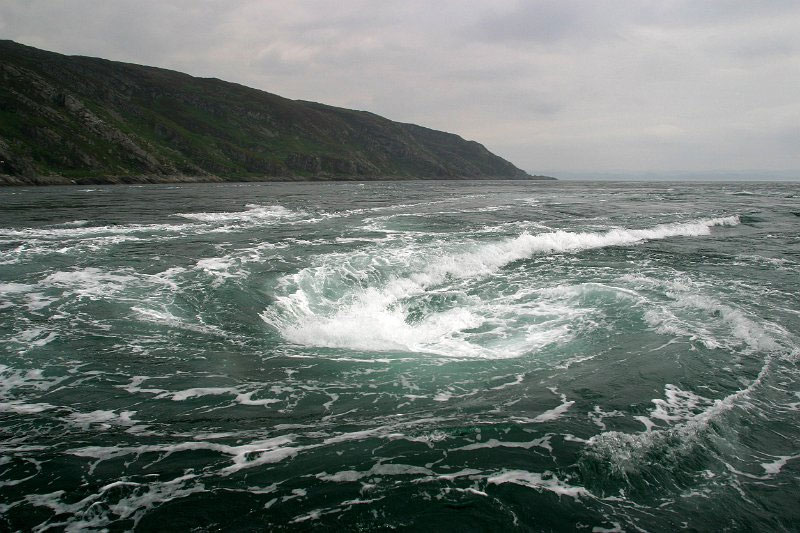Strange phenomena on the ocean
Ice flowers on the sea, red tide, colorful striped ice or ice whirlpools are strange natural phenomena that appear on the oceans.
Colorful striped icebergs
Depending on the ocean and the area of the iceberg, their temperature and characteristics are often different. This interesting phenomenon appears in cold waters and freezes near Antarctica. The striped ice sheets formed by blue and white glaciers collided, part of the iceberg broke and melted into each other, then froze once again to form icebergs. In the process of freezing, the impurities and liquid particles get mixed, making the ice blocks have different color layers.
Whirlpool
Water swirling is a dangerous phenomenon in the ocean. This is essentially a large destructive whirlpool, quickly sucking anything that appears in the vicinity. Weather is a factor that determines the force and speed of a whirlpool. There are many legends that vortices will immediately submerge everything to the bottom of the ocean, but scientists deny this hypothesis.
Red tide
Red tide formed due to the strong development of toxic algae. Algae will produce toxins and elements harmful to marine animals, fish, birds and even humans. One of the most well-known red tides often occurs every summer along the Gulf of Florida, USA.
Whirlpool ice
Ice whirlpools form when salt-rich water is separated from ice sheets on the sea, then deposited and create a unique ice shape. Extremely low temperature is a necessary condition to create ice whirlpools so this phenomenon only occurs in icy waters around the Arctic and Antarctic. Ice whirlpools have tremendous destructive power to marine life where they appear. Starfish, fish and even seaweed die or freeze when exposed to ice whirlpools.
Ice flowers
Ice flowers are formed on the young sea ice in cold seas. Ice flowers only form in cold and windy conditions. The cluster of ice has a diameter of 4 cm and usually has the shape of a flower. Because of the formation of seawater, the ice flowers crystallize high salt content.
The longest wave in the world
The longest wave, also known as Pororoca, appears on the Amazon River in the Brazilian territory. This phenomenon only occurs once every 2 years, between February and March. The tide going through shallow water at the mouth of the river will form waves of up to 6 meters, lasting up to half an hour before shoving the shore and sweeping away everything on the way - from houses, trees to animals.
Death waves
Death waves, also known as poison waves. These waves often appear unexpectedly without warning. Giant waves can reach a height of up to 40 m often appear in offshore areas. Death waves are an unforeseen danger for ships traveling on the sea.
Two-color seawater
When two tidal currents meet at one point, Skagen, Denmark, seawater will have two different colors. Due to different densities and density, the two tidal currents confront each other, but never become one.
Bioluminescence
Bioluminescence occurs when light emitted from a living organism combined with oxygen in the air causes chemical reactions. This phenomenon makes the whole ocean sparkle like being lit.
Milky Sea
This phenomenon takes place in the Indian Ocean. Similar to bioluminescence, this is a glowing phenomenon in the ocean, but with milk-colored light, forming an image like a galaxy. The cause of this phenomenon is due to a bacterium that turns seawater into blue, but in the eyes of people, they still carry the sparkling color of the 'galaxy'.
- Paranormal phenomena from the universe
- Top 15 strange natural phenomena (2)
- 5 strange phenomena happen while sleeping makes many people panic
- Strange phenomena can only be seen in the universe
- The people rushed to see the strange
- The ocean will become a strange world every night
- Explain the 'bursting' series of 'strange phenomena' that make everyone ache
- 10 strange natural phenomena that cannot explain in the Solar System
- Strange phenomena will help you realize the true power of nature
- Top 15 strange natural phenomena (1)
- The most incredible natural phenomena in the world
- Strange phenomena appear in the sky










 Surprised: Fish that live in the dark ocean still see colors
Surprised: Fish that live in the dark ocean still see colors Japan suddenly caught the creature that caused the earthquake in the legend
Japan suddenly caught the creature that caused the earthquake in the legend A series of gray whale carcasses washed ashore on California's coast
A series of gray whale carcasses washed ashore on California's coast Compare the size of shark species in the world
Compare the size of shark species in the world